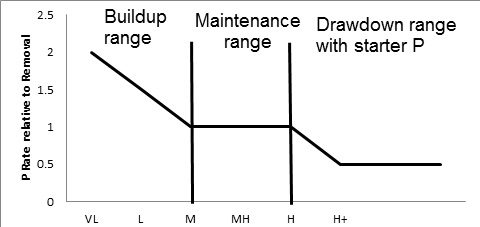Did you know?
Soybeans remove 0.84 lbs P per bushel, which means a 40 bu/ac soybean crop removes 34 lbs P/ac. Attention must be paid to ensure a proper fertilization strategy is adopted to ensure application rates are meeting removal rates through the entire crop rotation – learn more below.
Medium to high soil test P levels (10-20 ppm) are optimal for soybeans. However, research from the University of Manitoba has determined that soybeans generally do not respond to phosphorus fertilizer, regardless of rate or placement (Bardella, 2016). This lack of response was evident even at very low soil test levels.
Manitoba fertilizer phosphorus (P) guidelines have not been updated since 1992 and some troubling trends have been identified:
- In several of the past years the crop removal of P has surpassed the application rate of fertilizer P
- More soil test values are declining into the LOW range in some areas of Manitoba
According to 2016 soil test results from Agvise, large percentages of fields in Manitoba have reached low levels of Olsen P (<10 ppm). Frequent soybean production in a rotation can worsen this issue, affecting crops that are more sensitive to P deficiency. Low soil test P levels in the northeast corner of Manitoba may be attributed to frequent soybean production over several years.
Phosphorus removal rates are generally greater than application rates in Manitoba. This is likely due to limited capacity for application of seed-placed phosphorus fertilizer, particularly with sensitive crops like canola or soybeans. The maximum safe rate of seed-placed phosphorus with soybeans is 10 lbs P2O5 /ac for wide rows, or up to 20 lbs P2O5 /ac for narrow rows with good soil moisture. A 40 bu/ac soybean crop removes approximately 34 lbs P2O5/ac, or 0.84 lbs P2O5 /bu. Therefore, it is important to develop a crop rotation strategy that ensures P removal rates are balanced with P inputs.
This decline in soil test P levels (STP) may arise for a number of reasons:
- Changing crop acreages– from relatively low P removal crops of cereals and flax to canola, soybeans and corn
- Move to low disturbance seeders and planters with narrow openers and wide row spacings (low seedbed utilization) which limit the safe rate of seed row applied fertilizer, especially with sensitive crops such as canola and soybeans
- Promotion and adoption of low P rate starter fertilizers that do not replace P that is removed by crops
- Increase in grain yields since development of original MAFRD recommendations in the early 1990s due to breeding (ie introduction of hybrid canola, general purpose spring wheats etc.) and technology (ie fungicide use)
- Provincial recommendation tables do not include yield adjustment factors, so rates have been inadequate to meet current yield levels, let alone match rates of P removal
Since soybeans are relatively unresponsive to P fertilizer at any rate or placement, farmers can utilize soybeans as an opportunity for flexibility of P fertilizer application throughout the crop rotation. Use the Phosphorus Fertilization Calculator (Table 1) to balance P fertilizer inputs and P removal from harvested grain throughout the entire crop rotation. Removal of P for different yield targets can be adjusted.
To balance P removal, phosphorus fertilizer could be applied with soybeans at the rate of removal if applied away from the seed (i.e., side or mid-row banding). Higher rates of phosphorus fertilizer can be applied during the cereal phase of a crop rotation because cereals are generally more tolerant to seed-placed fertilizer. Broadcasting P fertilizer prior to or after seeding can help increase soil P levels, but there is a risk of P losses from erosion and run-off. Manure can also be utilized to build soil P, but would likely be more beneficial applied prior to more P responsive crops (canola or cereals).
Soil conditions have shifted from wet to dry in many areas across Manitoba, which is generally good news for seeding a lot of acres. However, dry conditions can increase the risk of fertilizer losses. For tips on applying fertilizer under dry soil conditions, click here to read the article by John Heard (Crop Nutrition Specialist, Manitoba Agriculture) on Crop Chatter.
Thinking about your, or your client’s, cropping system does P applied equal P removed? Or are crop removal rates exceeding P applied, leading to a negative soil P balance?
Use the Interactive Phosphorus Balance Calculator to determine your annual P balance:
Interactive Phosphorus Fertilization Calculator
Phosphorus Recommendation Strategies for Manitoba
Manitoba Soil Fertility experts have collaborated to develop “Phosphorus Fertilization Strategies for Long Term Agronomic and Environmental Sustainability” which outlines:
- Why declining P fertility is a concern
- Reasons for adopting a new, long-term strategy to address declining P fertility
- Four options for implementing a long-term strategy to maintain soil test P levels in a “maintenance range”

Acknowledgements: Calculator and Information developed by John Heard (Manitoba, Agriculture, Food and Rural Development), Dr. Cynthia Grant (Agriculture and Agri-Food Canada) and Dr. Don Flaten (University of Manitoba).
